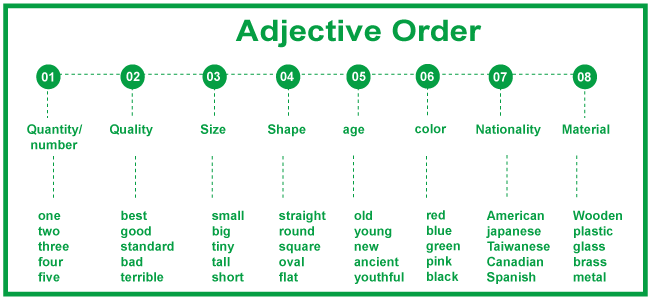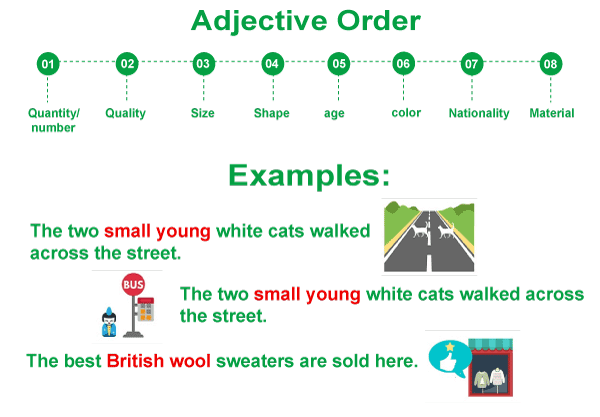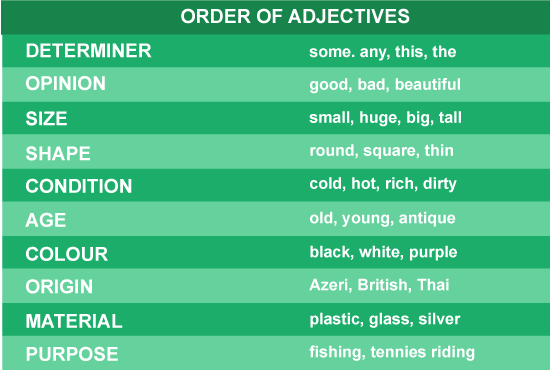Order Of Adjectives
Whenever someone uses more than one adjective prior to a noun in English, the adjectives are frequently used in a precise sequence. It can sound weird if the adjectives are not in the correct order. However, there are two points to consider.
- Firstly, it’s relatively uncommon to utilize more than three adjectives in front of a noun.
- Secondly, the sequence might be varied at times, usually to emphasize something.

For example, look at this sentence “Every Saturday, my granny makes an Asian big supper,”.
This sentence is technically right-it’s large supper, it’s Asian food, and it’s made by the granny. However, it does not sound quite right, and that’s due to the fact that the adjective order in that statement is incorrect.
Most kids learn adjective order by listening and reading rather than through classroom instruction. Since the rules for adjective order in English are more explicit than in other dialects, putting adjectives in a specific sequence sound “right,” and diverging from that order makes a sentence seem “wrong,” even if it is grammatically correct.
Adjective order in English Grammar
In English Language, the right sequence for adjectives is called as the Royal Order of Adjectives. The following is the Royal Order of Adjectives:
1. Determiner (Although not an adjective, determiners encompass article, possessive, and demonstrative) are included in the Royal Order of Adjectives. Adjectives and the nouns they alter must always appear before them.)
Then, your, our, these
2. Quantity
One, seven, six, five, many, and few.
3. Opinion
Tasty, brave, foolish, beautiful, lovely, and priceless.
This group is sometimes separated into two parts: broad and specific opinion, with broad or general opinion coming first. For instance, you could advertise a certain iPad as a popular and ideal choice for graphic designers. The overall opinion here is that it is well-liked, and this is an opinion shared by many.
The more precise opinion is that it’s ideal for digital illustrators-this is your personal view, but it may not be as generally held as the public one.
4. Size
Big, teeny-tiny, average, huge, small, tiny, and little.
5. Age
Fresh, young, old, half a century old, second-newest
6. Shape
Circular, square, spherical, triangular, rectangular
7. Color
Purple, white, yellow, orange, and Green
8. Origin/materials
Asian, Italian, steel, wooden, iron, cotton, silk, African, Russian
9. Qualifier
Dracula bat, hound dog, leather skirt, sleeper cab
Although you might not have seen the right adjective order presented in this manner before, you may have picked it up and implemented it without even realizing it. This order is naturally followed whenever more than one adjective is used to describe a noun, regardless of where those adjectives belong within the Royal Sequence.

Have a glance at the following table to determine how various noun phrases are organized in the Royal Order;

Notice how, even if you don’t use an adjective from each group, you still employ this order?
Even if you have a precise adjective order to maintain, there are times when you need to vary the order to adequately explain your message. One of these situations is when one of your sentence’s adjectives is part of a compound noun. Consider the following example:
He relocated to a brand-new big home.
However, this sentence should read, “He relocated into a big brand-new home,” as per the Royal Order of Adjectives, right? Yes, if you’re referring to a relatively bigger new home. However, if you’re referring to a big home, the answer is no. There are numerous ways in which English might be perplexing, and in certain cases, there is a hidden logic behind it.
Why do adjectives have to be in this particular order?
It’s an unsatisfactory reply, but it’s the only one: we don’t know. There are, however, some theories. One is that the nearer an adjective is to its noun, the more important it is in describing the noun. Describing a house as a “wooden house,” for instance, is more precise than describing it as an “ancient house” or a “lovely house.” Although, this theory is not necessarily the most accurate or the precise one. To provide another example, consider the terms “big dog” and “brown dog.” Is it true that a brown dog is a more particular description than a big dog?
Like other oddities of the English language, Adjective order is something you just have to accept.

The Use of Commas with Adjectives
When multiple adjectives are in a statement, some require commas while others do not.
Isn’t it confusing?
It’s absolutely not that terrible; there is a logic to this one.
- Whenever two or more adjectives from the same group are used, they must be separated by commas:
They rode in a comfy, lavish car. - When the adjectives belong to different groupings, they aren’t separated by commas:
She has a lush green lawn in the back. - A comma should never be used in between final adjectives and the noun it describes.
- A comma must never be utilized between a noun’s determiner and its adjectives. A determiner is a term that appears at the outset of a statement or a phrase and conveys how many and which noun is being described.
As an example:
- That vehicle
- Two swans
- My college
When you combine these statements with some adjectives, you get:
- That Blue rectangular vehicle.
- Two chubby white swans.
- My dynamic, robust old college.
If you’re unsure whether to use a comma, try this simple trick: if you can add the word “and” in-between adjectives and invert the order of the adjectives without compromising the sentence’s coherence, you wouldn’t require a comma.
- My profound, arduous, and esteemed college
- My profound, esteemed, and arduous college
How Sentence Placement Affects Adjective Order
Adjectives come prior to the noun they describe or alter in a phrase. Usually.
Consider the following sentence:
The stage show was boisterous and packed.
In this statement, they come after the verbs (“to be,” that is in the past tense here: was).
The sentence can be readily rewritten as follows:
It was a boisterous, packed stage show.
Both are true. However, when your adjectives come after your verb, as in the instance above, they do not satisfy the same comma restrictions as to when they come before your noun. When the final word in a phrase, clause, or sentence contains an adjective, it must be followed by “and”:
Her cat was tiny and black; it was a Persian.
When there are three or more adjectives, the comma position is determined by whether your style comprises the Oxford comma, often called as the serial comma. If the Oxford comma is not used, each adjective preceding the second-to-last one must be distinguished by a comma:
Their home is small, cramped, and contemporary.
If you’re using the serial comma, split each adjective with a comma:
Their home is small, cramped, and contemporary.
As an example:
- I adore that really small old black vintage car that remains placed at the end of the colony.
- My sister got a gorgeous huge white pit bull.
While there are two or more adjectives from the similar category, the term and is put in- between them:
- The cottage is red and blue.
- The institution has old and new publications.
Suppose there are three or more adjectives from the same adjective group, then in that case a comma should be included in- between every coordinate adjective:
- We reside in the huge red, blue and pink home at the end of the main road.
- My buddy misplaced his grey, blue and white wristwatch.
A comma should not be used between an adjective and a noun.

Here are some more examples. These will help you better understand the concept of the order of adjectives.
- I adored the lovely old large golden antique Ferrari that remains parked at the end of the block. [quality – age – size – color – proper adjective]
- His brother has a huge lovely tan and black Labrador dog. [dimensions – quality – color – color]
- A lovely ancient Italian clock. [opinion – age – place of origin]
- A large blue rectangular container. [size – shape – color]
- A horrible yellow plastic trinket. [Opinion – color – material]
- Some sleek new Italian slacks. [dimension – age – origin]
- A fantastic new Asian film. [opinion – age – origin]
- I purchased a pair of brown suede bellies. [color – material]
- I like huge brown dogs.[ [ size, color]
- Lisa was wearing a beautiful short golden dress. [opnion – size- color]
- I bought a huge grey trolley.[size-color]
- They have a few new American wall decor. [ quantity-age-origin]
- That is a really beautiful wooden table. [opinion-material]
- They purchased a new circular table. [ age-shape]
- There are a lot of African participants in the class. [ quantity- origin]
Note: However, the precise sequence of adjectives is not agreed upon by all grammarians, and the detailed rules are difficult. The criteria apply to adjectives in their “natural” order. These standards are not restrictive, and you might just wish to modify the order for emphasis on occasion. Consider the following discussions:
Dialogue 1:
- “I would like to purchase a square desk.”
- “Would you like to buy a new square desk or an old square table?”
Dialogue 2
- “I would like to buy an ancient table”.
- “Would you like a round ancient table or square antique table?”
